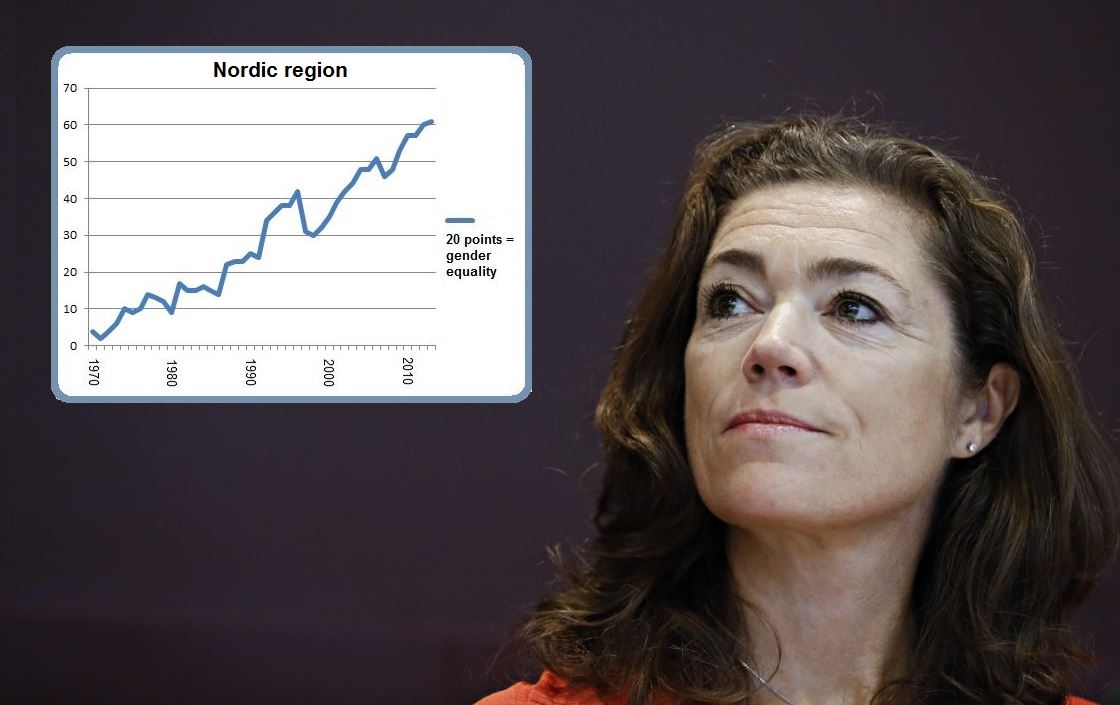The largest change for 2012 came as Wanja Lundby-Wedin stepped down
as President for the Swedish Confederation of Trade Unions. Iceland got
their first female Minister of Finance and a female bishop.
NLJ’s gender equality barometer tries to reflect women’s influence
in 13 government ministry posts, major labour market organisations and
other symbolically important positions like head of state,
commander-in-chief and central bank head.
Looking exclusively at the number of women in governments, the
Nordic countries all sit at around 50 percent:
| Country | Ministers | Women | Percent |
|---|---|---|---|
| Iceland | 9 | 5 | 55.6 |
| Sweden | 24 | 13 | 54.2 |
| Norway | 20 | 10 | 50.0 |
| Denmark | 23 | 11 | 47.8 |
| Finland | 19 | 9 | 47.4 |
| Nordic region | 95 | 48 | 50.5 |
Since certain ministers have more power than others, or are
symbolically more important, this is a rather unclear measurement of
equality. We have chosen to give all ministers one point while the
Prime Minister gets five, Finance Minister three and Foreign Minister
two points. We have compared the 13 ministers who participate in the
Nordic Council of Ministers or who normally are part of a government.
The President of the Confederation of Trade Unions gets four points,
while the leaders for the professional and academic trade unions get
two points each. On the employer side we have given two points for
board directors and two points for CEOs. See here for a full list.
All surveys have weaknesses. Earlier we have given women points as
long as a woman held a government minister post for more than one month
in that year. But when Kristin Skogen Lund went from being the board
director to President of the Confederation of Norwegian Enterprise,
this would mean she counted twice in 2012.
We have therefore adjusted our barometer to measure who sits in a
certain position on International Women’s Day, 8 March, each year. This
makes our gender equality graph a bit longer than before. The biggest
difference is that Finland’s first female Prime Minister Anneli
Tuulikki Jäättenmäki, who served between 7 April 2003 and 24 June 2003,
does not make it.
At the same time things are moving faster than we thought they
would. When we presented our first barometer three years ago, we looked
at which positions women had not reached in any Nordic country, and
which positions were not held by women in the individual
countries.
One such Nordic position unconquered by women was archbishop. Since
then, however, Helga Haugland Byfuglien has been elected bishop in the
Church of Norway (on 2 October 2011) – the closest thing to an
archbishop you get in Norway. Iceland has only one bishop, also now a
woman, since the ordination of Agnes M. Sigurðardóttir on 24 June
2012.
Three years ago Denmark had never had a female Prime Minister,
Finland had never had a female Finance Minister and Norway had never
had a female head of the employers’ association. All these posts have
since been held by women.
Never a female chief of defence in the Nordic region
The one remaining symbolic function never yet held by a woman in any
Nordic country is chief of defence.
However, there are still many positions where the first woman is
still to be appointed:
Denmark – never had women leading the Confederation
of Trade Unions or the employers’ association. There has also never
been a female bishop of Copenhagen (there is no archbishop title in
Denmark), a head of police or supreme court leader.
Finland – has the worst gender equality of all
Nordic countries when it comes to labour market organisations. Neither
the Confederation of Trade Unions, the Confederation of Professional
Employees nor the employers’ association have ever been led by a woman.
Finland also has no female archbishop, supreme court leader or head of
police.
Iceland experienced a gender equality boom in many
ways after the finance crisis, when many men were blamed for the
collapse of the country’s banks. Although there is a female Prime
Minister, many government ministries have never been headed by a woman.
Here too there is a lack of gender equality among employers, in the
police and in the coast guard (since the country has no standing army).
The Left-Green Movement recently changed their party leader – Katrín
Jakobsdóttir took over from Steingrímur J. Sigfússon. Just before that,
however, Iceland’s Social Democratic Alliance changed their party
leader. Árni Páll Árnason took over from Johánna Sigurðardóttir, who
continues as Prime Minister. On 27 April Iceland holds parliamentary
elections.
There are elections in Norway too, on 9 September.
This year Norwegians have celebrated 100 years of female voting rights.
The aim is a particularly high number of women voters this year. Prime
Minister Jens Stoltenberg’s seat is not safe, according to opinion
polls. The country’s next Prime Minister will therefore not unlikely be
a woman – Erna Solberg from the Conservative Party. In May the
Norwegian Confederation of Trade Unions will also elect a new leader
after Roar Flåthen.
Sweden has never had a female Prime Minister, the
top position of power in the Nordic region still never held by a woman.
The head of state has never been a woman either, but at least one is
now lined up. Neither the church, the central bank nor the police have
had female leaders. The fact that the head of the Swedish Confederation
of Trade Unions, Wanja Lundby-Wedin, was followed by Karl-Petter
Thorwaldsson gave the largest swing on the NLJ’s gender equality
barometer – because that position counts for four points.





